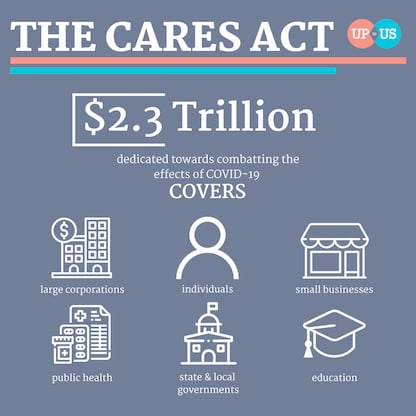
The COVID-19 pandemic has changed the way we live our lives–from where we work to how we learn. As universities grapple with these changing realities, the federal government has introduced new funding programs that schools can use to ease this transitional period.
Suitable has helped hundreds of schools transition their unique student experiences from in-person to a more adaptable virtual or hybrid model while keeping students engaged and on the right track towards achieving their goals. With these new government funding programs, universities can introduce technologies like Suitable to adapt existing course offerings and outside-the-classroom experiences to our new reality, without losing students’ attention.
In this guide, you can find everything you need to know about these new funding programs, eligible uses, and how to use available funds to partner with Suitable.
Contents:
- What is the CARES Act?
- What does the CARES Act mean for higher education?
- How can individual schools access and use the CARES Act funds?
- CARES Act History & Grants So Far
- CRRSAA Act History & Grants So Far
- American Rescue Plan History & Grants So Far
- CARES Act Funding FAQ
- CRRSAA Act Funding FAQ
- Questions We Are Still Left With
- Where Does Suitable Come In?
- Get Your Justification Letter
Let's start with the basics.
What is the CARES Act?
In response to the detrimental economic impacts of the COVID-19 pandemic, the federal government enacted The Coronavirus Aid, Relief, and Economic Security Act (CARES). This bill allotted $2.2 trillion to provide fast and direct economic aid to negatively-impacted Americans.
Within this allotment, $14 billion went to the Office of Postsecondary Education as the Higher Education Emergency Relief Fund (HEERF).
What does it mean for Higher Education?
This means that institutions could receive millions in grant funding to ensure that learning continues for students during the pandemic. What exactly schools can use these funds for is different depending on whether the school is public/private and non-profit/for-profit.
There have been three appropriations made to the HEERF and schools have until September 30, 2023, to access the most recent funding.
How can individual schools access and use the funding?
Suitable can help you transition your student experience to virtual/hybrid, which makes the purchase of Suitable an allowable use of the funds. Keep in mind, schools are subject to an allocation formula that will determine how much funding they are eligible for. Here, we’ll highlight in more detail the key areas of funding documentation that offer insight into how schools can use available funding, and how much they might be entitled to. Check out the “Institutional Portion Allowable Uses” section to see where schools can justify Suitable as a necessary expense of their HEERF funds. Keep in mind, each state may have different funding guidelines and deadlines for the grants that can be submitted.
For a comprehensive breakdown of each act, check out this comparison chart–otherwise, we’ve pulled out the most pertinent details and summarized them for your convenience below.
Here are the types of funds that have been awarded to institution so far:
The Coronavirus Aid, Relief, and Economic Security Act (CARES Act) / HEERF I Fund
The Coronavirus Aid, Relief, and Economic Security Act (CARES Act) was signed on March 27, 2020, allotting $14 billion for higher education needs. Funds are awarded directly to students as “Emergency Financial Aid Grants” to be used for any expenses related to the disruption of campus operations and other Cost of Attendance (COA) expenses such as food and housing.
Institutions, however, can use any funds to cover defraying expenses due to significant changes to the delivery of instruction due to the pandemic and award additional financial aid grants to students.
The Coronavirus Response and Relief Supplemental Appropriations Act (CRRSAA Act) / HEERF II Fund
The Coronavirus Response and Relief Supplemental Appropriations Act (CRRSAA Act) / HEERF II Fund was signed on December 27, 2020, awarding an additional $23 billion to universities. Similar to the CARES Act, there are required student spending limits. For-profit universities, for instance, have to use 100% of the CRRSAA funds towards student grants.
Students can use their grants towards any COA expenses or any emergency costs due to the pandemic, such as tuition fees, food, and health care.
Institutions, on the other hand, may use these funds to cover any pandemic-induced expenses from loss of revenue to faculty training to technology costs. Institutions can also award additional financial aid grants to students, similarly to the CARES Act.
American Rescue Plan Act (ARPA Act) / HEERF III Fund
American Rescue Plan Act (ARPA Act) / HEERF III Fund was signed on March 11, 2021, awarding an additional $40 billion which will be available through September 30, 2023, with required student spending.
At least 50% of an institution's total allotment must go towards student grants. Similar to the CRRSAA funds, all for-profit universities must use 100% of their funds towards student grants that can be used towards any of the students’ needs from housing to healthcare.
CARES Act Funding FAQ
We researched and evaluated the FAQ pages to provide you with the most relevant information you may need to vet Suitable and other eligible technology.
Some of our university’s students require additional support for purchasing laptops, hotspots, or other information and technology equipment for their online learning. Can universities use the funds for Recipient’s Institutional Costs to purchase these for students in need? Can universities also use those funds to reimburse themselves for equipment we already purchased for our students?
Yes! Institutions can use the Recipient’s Institutional Costs funds to purchase equipment for their students at home. Additionally, funds can be used to pay for online licensing fees and internet services so students can be well-equipped for all of their online classes at home. For universities who already purchased and distributed equipment to their students on or after March 12, 2020, they may reimburse themselves for these costs with the Recipient’s Institutional Costs.
Some of our students aren’t struggling with access to technology but are still struggling financially due to the pandemic. Can universities provide financial aid for students to students who were enrolled exclusively in online classes prior to the pandemic?
Unfortunately, no. Institutions that provide both online and in-person learning can not distribute financial aid through the Recipient’s Institutional Costs to students enrolled in only online classes on March 13, 2020. According to the CARES Act, student emergency financial aid grants are for expenses related to “the disruption of campus operations due to coronavirus” and online-only
For more information, please refer to the CARES Act official FAQ Sheet https://www2.ed.gov/about/offices/list/ope/heerfinstitutionalfaqs.pdf
CRRSAA FAQ
How has the use of funds changed for institutional uses?
Institutions have become more and more flexible when it comes to their supplemental Institutional Portion Funds (CFDA 84.425F). In fact, under section 18004(c) of the CARES Act, institutions are required to use their Institutional Portion awards to cover any costs due to the changes in classroom instruction and for additional emergency aid grants, which have limitations of their own.
However, the following are the allowable uses under the CRRSSA for Institutional Portion Awards, according to the HEERF II:
- Defraying expenses associated with coronavirus (including lost revenue, reimbursement for expenses already incurred, technology costs associated with a transition to distance education, faculty and staff training, and payroll)
- Carrying out student support activities authorized by the Higher Education Act of 1965, as amended (HEA), that address needs related to coronavirus
- Making additional financial aid grants to students (as described in Question 8).
Additionally, according to section 314(d)(3) of the CRRSAA, supplemental Institutional Portion awards can NOT be used towards funding the following:
- Contractors for the provision of pre-enrollment recruitment activities, marketing, or recruitment
- Endowments
- Capital outlays associated with facilities related to athletics, sectarian instruction, or religious worship
- Senior administrator or executive salaries, benefits, bonuses, contracts, incentives
- Stock buybacks, shareholder dividends, capital distributions, and stock options; or any other cash or other benefits for a senior administrator or executive.
For additional information, please refer to the official CRRSAA FAQ Sheet https://www2.ed.gov/about/offices/list/ope/faqsfora1crrsaaheerfii.pdf
What “student support activities” may CRRSAA funds be used to support?
Section 314(c)(2) of the HEERF II notes that institutions are allowed to spend their CRRSAA funds on student support activities that addresses needs related to the coronavirus pandemic that are authorized by the HEA. These could be:
- Support for transitioning to virtual learning and events
- Purchase of PPE
- Support for other virtual learning methods qualified and authorized under the HEA pandemic provisions.
Additionally, universities can use these funds towards other activities such as TRIO and Gaining Early Awareness and Readiness for Undergraduate Programs (GEAR UP) to the extent of which those activities address needs presented by the pandemic.
For more information, please refer to the CRRSAA official FAQ Sheet https://www2.ed.gov/about/offices/list/ope/faqsfora1crrsaaheerfii.pdf
Questions We’re Still Left With (check back here soon for answers)
At the moment, the answers to the following questions remain unknown. NASFAA hopes to be able to address these questions in the near future and will update this reference page on a rolling basis as ED provides additional guidance.
- How long does my institution have to spend our HEERF III funds?
- If I received funds through the CARES Act or the CRRSA Act do I need to do anything to receive my HEERF III allocation?
- What are the reporting requirements for the HEERF III funds?
Where Does Suitable Come In?
For the past year, students have been hopping from one Zoom class to another, while campus leaders have been anxiously watching their retention and student engagement rates.
With over 100 partners, Suitable has helped institutions like yours beat “Zoom Fatigue” while addressing both engagement and retention. We do this by providing new and engaging activities while still keeping students in the loop. These activities can be a good break for students to actually engage with the university at home without having to sit on a Zoom call.
Here's what our partners have come to expect this last year:
- Increased ROI
- Increases in student engagement and retention rates through the pandemic
- Seamless integrations that make setup a snap
Now, with help from the CARES, CRRSA, or ARPA programs, your school can fund Suitable as a way to support your transition to virtual learning and events, and for technology costs associated with distance learning.
If universities and colleges are to successfully meet the needs of students post-pandemic, a smooth transition to a virtual or hybrid learning model is essential. With intuitive, mobile-first programming, schools simply brand their experience, set up their activity catalogs, and let us take care of the rest.
With virtual learning tools designed for desktops, tablets and smartphones, Suitable meets students where they are, providing them with full access to all the activities and experiences your campus has to offer--no matter where they are. Here are just a few of the tools schools have found useful in transitioning to a more flexible learning model:
- Unified event tracking
- Built-in reflection assignments
- Real-time, app-based notifications to replace often-ignored emails
- Timely intervention for students falling behind
- Achievements and rewards for students progressing ahead of schedule
- And MORE!
Create Your Own CARES Funds For Suitable Justification Letter
Applying for funding from these programs and allocating those funds for new technology purchases can be big asks, especially with so many departments looking for help right now. We want to make this ask as simple as possible for you.
Download this template to create your own CARES Funds For Suitable justification letter. Arm yourself with this guide and the info within. If any further questions arise, reach out to us for a free consultation and let one of our CARES Act experts walk you through the next steps. We can't wait to see what you do with this opportunity.


.png)
